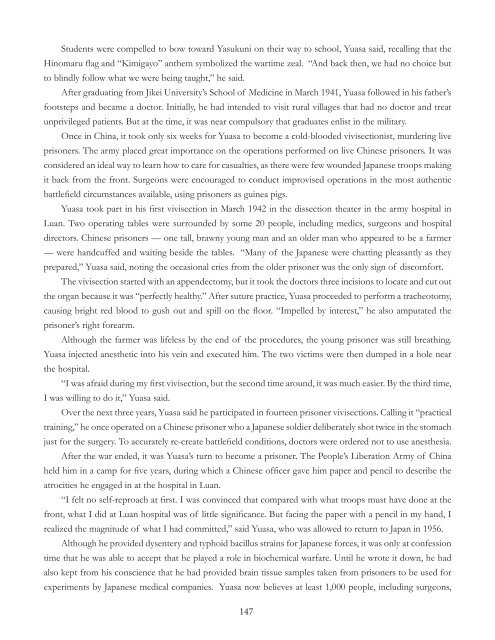Download - Canada ALPHA
Download - Canada ALPHA
Download - Canada ALPHA
Create successful ePaper yourself
Turn your PDF publications into a flip-book with our unique Google optimized e-Paper software.
Students were compelled to bow toward Yasukuni on their way to school, Yuasa said, recalling that the<br />
Hinomaru fl ag and “Kimigayo” anthem symbolized the wartime zeal. “And back then, we had no choice but<br />
to blindly follow what we were being taught,” he said.<br />
After graduating from Jikei University’s School of Medicine in March 1941, Yuasa followed in his father’s<br />
footsteps and became a doctor. Initially, he had intended to visit rural villages that had no doctor and treat<br />
unprivileged patients. But at the time, it was near compulsory that graduates enlist in the military.<br />
Once in China, it took only six weeks for Yuasa to become a cold-blooded vivisectionist, murdering live<br />
prisoners. The army placed great importance on the operations performed on live Chinese prisoners. It was<br />
considered an ideal way to learn how to care for casualties, as there were few wounded Japanese troops making<br />
it back from the front. Surgeons were encouraged to conduct improvised operations in the most authentic<br />
battlefi eld circumstances available, using prisoners as guinea pigs.<br />
Yuasa took part in his fi rst vivisection in March 1942 in the dissection theater in the army hospital in<br />
Luan. Two operating tables were surrounded by some 20 people, including medics, surgeons and hospital<br />
directors. Chinese prisoners — one tall, brawny young man and an older man who appeared to be a farmer<br />
— were handcuffed and waiting beside the tables. “Many of the Japanese were chatting pleasantly as they<br />
prepared,” Yuasa said, noting the occasional cries from the older prisoner was the only sign of discomfort.<br />
The vivisection started with an appendectomy, but it took the doctors three incisions to locate and cut out<br />
the organ because it was “perfectly healthy.” After suture practice, Yuasa proceeded to perform a tracheotomy,<br />
causing bright red blood to gush out and spill on the fl oor. “Impelled by interest,” he also amputated the<br />
prisoner’s right forearm.<br />
Although the farmer was lifeless by the end of the procedures, the young prisoner was still breathing.<br />
Yuasa injected anesthetic into his vein and executed him. The two victims were then dumped in a hole near<br />
the hospital.<br />
“I was afraid during my fi rst vivisection, but the second time around, it was much easier. By the third time,<br />
I was willing to do it,” Yuasa said.<br />
Over the next three years, Yuasa said he participated in fourteen prisoner vivisections. Calling it “practical<br />
training,” he once operated on a Chinese prisoner who a Japanese soldier deliberately shot twice in the stomach<br />
just for the surgery. To accurately re-create battlefi eld conditions, doctors were ordered not to use anesthesia.<br />
After the war ended, it was Yuasa’s turn to become a prisoner. The People’s Liberation Army of China<br />
held him in a camp for fi ve years, during which a Chinese offi cer gave him paper and pencil to describe the<br />
atrocities he engaged in at the hospital in Luan.<br />
“I felt no self-reproach at fi rst. I was convinced that compared with what troops must have done at the<br />
front, what I did at Luan hospital was of little signifi cance. But facing the paper with a pencil in my hand, I<br />
realized the magnitude of what I had committed,” said Yuasa, who was allowed to return to Japan in 1956.<br />
Although he provided dysentery and typhoid bacillus strains for Japanese forces, it was only at confession<br />
time that he was able to accept that he played a role in biochemical warfare. Until he wrote it down, he had<br />
also kept from his conscience that he had provided brain tissue samples taken from prisoners to be used for<br />
experiments by Japanese medical companies. Yuasa now believes at least 1,000 people, including surgeons,<br />
147


